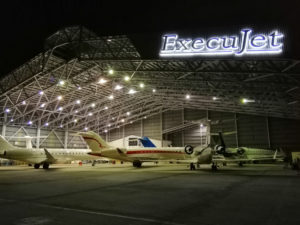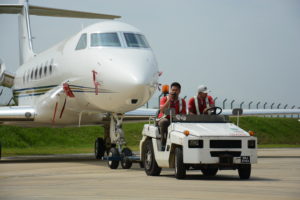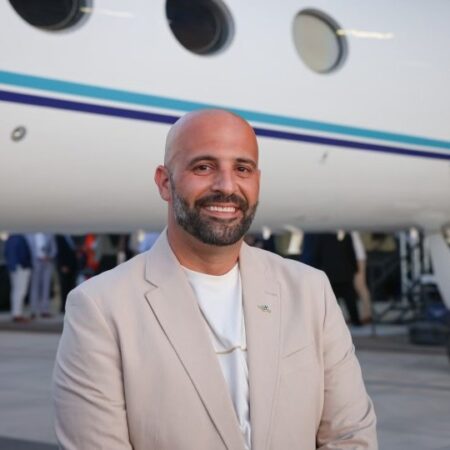Words by Kirstie Pickering
Business aviation in Malaysia is steadily on the rise, with a new development program by the country’s government set to help the industry boom.
The business aviation market has only blossomed during the past two decades in Malaysia and now demand for aviation services in the country is on the rise. With capital Kuala Lumpur’s status as a growing financial hub, booming industries such as oil and gas and the increasingly popular tourism market, Malaysia has much to offer those travelling by private jet.
Malaysia has attractive airport and handling fees compared to other countries in Asia Pacific. Operators require landing permission from the Civil Aviation Authority of Malaysia (CAAM) and once approved, airports simply allocate parking bays for the arriving aircraft.
Operators or owners that are flying to Malaysia don’t have to worry about unexpected paperwork or complex procedures exclusive to the region. Another plus is that the country’s main FBO, Skypark, doesn’t require slot booking and there is no flight curfew.
Competitive markets

In 2009, Subang Airport opened the Skypark terminal, a FBO and regional aviation center that aimed to enhance the country’s business aviation offering. Investment in such facilities has bolstered the potential for more growth in the sector, but Malaysia is competing with existing strong markets nearby.
Beijing, Hong Kong and Shanghai are the clear leaders in this sector, followed closely by Singapore
in terms of business aviation aircraft movements. Sultan Abdul Aziz Shah Airport in Malaysia trails closely at around 3,500 aircraft movements, ahead of those at Macau and Bangkok. However, Malaysia is unquestionably a competitor, with its strategic location and a city airport ecosystem at Sultan Abdul Aziz Shah Airport. It is also cost competitive in terms of labor and infrastructure compared to Hong Kong and Singapore.
“Most of the countries in the ASEAN region such as Malaysia, Singapore, Philippines and Indonesia have a resident business jet fleet of close to 60 aircraft,” says Amartya De, associate director for aerospace, defense and security at Frost & Sullivan. “Out of these, each country has a different proportion of locally registered business jets due to ease of registration, maintenance and other supporting policies. In the case of Malaysia, close to 30% are registered locally and the remaining sum are registered abroad.
“Fleet growth in the region has been between 4% and 12% recently and Malaysia has been slow in this regard. Thailand tops the charts with faster growth and a larger number of locally registered aircraft, though the absolute number of jets has stayed marginally behind the rest.”
Maintenance conundrum
The major original engine manufacturers (OEMs) in the market are Bombardier, Gulfstream, Cessna, Dassault and Hawker. The supporting infrastructure in Malaysia in terms of FBO is reasonably adequate with Customs, Inspection and Quarantine (CIQ) facilities, but that is not deemed enough.
“The other support system required for business jets is OEM owned, authorized service centers and third party centers for maintenance and repair services,” says De. “Though Malaysia has authorized service centers and third party centers, Singapore has a stronger presence in terms of MRO capabilities by the
OEM-owned service centers of Bombardier and Cessna.”
This conundrum is one that Dassault wanted to take on headfirst. In January of this year, the company announced that it would be acquiring ExecuJet’s MRO business at Subang Airport. ExecuJet MRO Services – the name it has since rebranded as – is the largest business aviation MRO in Malaysia. It has a 64,000ft² facility that includes hangar space and adjacent office and workshops. Interestingly, most of ExecuJet MRO Services Malaysia’s business comes from overseas, most notably China, Hong Kong, Indonesia, Singapore and Thailand.
“Malaysia is an ideal place to have a business aviation MRO, not just because of its central location, but because Malaysia is one of the few countries in the region that has a capital city airport dedicated largely to business aviation,” says Jean Kayanakis, senior vice president of Falcon customer service and service center network at Dassault. “Subang Airport, which is conveniently located near downtown Kuala Lumpur, is mostly business aviation. The commercial Kuala Lumpur International Airport (KLIA) is located further away from the city.
“Malaysia has a skilled and qualified workforce. There are a good number of qualified and skilled maintenance technicians and engineers in Malaysia.
Malaysia is also attractive because the government – through linked organizations such as Malaysia Airports Holdings Berhad – is making an effort to position Malaysia as a centre for business aviation in the region.”
Ready to grow

This push for growth is set to transform business aviation in Malaysia. The most notable action is the Subang Airport Regeneration program. This is an initiative by Malaysia Airports to rejuvenate Subang Airport, capitalizing on the key strengths of the airport and surrounding aerospace ecosystem.
The program is centered on the three strategic focus areas of the city airport, business aviation hub and aerospace ecosystem. It is focused on the expansion and upgrading of the existing terminal and airside facilities to create a city airport, remodelling as a business aviation hub, and having a complete aerospace ecosystem to support the MRO and aero-manufacturing activities for the region.
Currently, Subang Airport Regeneration is at the master planning stage, which is expected to complete by mid-2020. The development plan is expected to commence following the completion of the masterplan. It is hoped that the business aviation hub will become a regional hub with a full suite of value chain and services linked to the business aviation sector, connecting high net worth individuals and attracting investments along the way.
“To grow further, the airport infrastructure needs to be upgraded and marketed as business aviation friendly,” says Ivan Lim, vice president at ExecuJet MRO Services Malaysia. “It is encouraging to note that Malaysia Airports has already started to embark on this via its Subang Airport Regeneration development plan. The focus is currently on Subang Airport due to the fact that it is the business aviation hub of Malaysia, but in due time other airports in Malaysia will be considered as well.
“We are moving in the right direction. The government is supportive of the aviation industry as the country positions itself to be an aviation hub in the region. From an industry perspective, more business aviation operators are now significantly experienced compared with recent years. The presence of a few major business aviation players in the country certainly helps,” adds Lim.
Facing challenges

Despite the positive action being taken to transform Malaysia’s business aviation offering, the mission isn’t without its challenges. These include slot unavailability, parking congestion, high parking charges and inadequate space for infrastructure development.
Skypark FBO, the country’s busiest and dominant FBO, has handled 40 to 50 arriving and departing flights each month this year. Despite the repeat clients, key issues are stunting faster growth.
“The key obstacles are a decline in the number of movements due to the global economic crisis, increasing competition around the region offering hangar parking space, and pressure from escalating fuel prices, foreign exchange volatility and overcapacity in the domestic market,” says Hariss Abdullah, general manager at Skypark FBO.
“To combat this, there needs to be a focus on improving yield through better pricing strategies, especially on premium segments of chartering a private jet. There should be a reconsidering of the permit approval period for a private jet and all parties and organizations must offer support to Malaysian operators. With full support from all agencies such as the government, tourism, the private sector in addition to economic growth, the business aviation market in Malaysia will be successful,”
he adds.
The Asian Business Aviation Association (AsBAA) acknowledges its role in accelerating the industry and is involved with the Subang Airport Regeneration program.
“Malaysia is very business aviation friendly,” comments Emil Pope, member of the AsBAA board of governors. “The country offers the perks of nearby countries such as Singapore, Indonesia and Thailand without the congestion, restrictions or limitations.
“Malaysia needs more FBOs in principal cities such as Penang, Johor Baru, Ipoh, Melaka, Kota Kinabalu and Kuching, all with additional parking, MRO and other popular incentives for the industry. There is great potential and significant room for growth.”
Looking forward
There is clear potential for a boom in Malaysia’s business aviation sector if these challenges can be overcome.
“The key success factors for the promotion of business aviation in Malaysia would be 24 hour operational flexibility so that scheduled flights cannot hamper private and charter operations,” says Frost & Sullivan’s De.
“In addition, landing and parking permits that have extensive documentation and long lead times are areas which could use digitalization. Enabling real time booking and online approval for landing requests and permits is crucial. Long term parking and hangar options for private aircraft owners are also necessary.
“At the same time, business aviation users prefer a dedicated and private terminal, including CIQ facilities away from commercial airline operations. Strict enforcement of rules, regulations and contracts in the airport to maintain discipline is a key requirement. Customs clearances for aircraft parts without any delays in clearance would support MROs to reduce their turnaround time for repairs and maintenance activities.
“If Malaysia does not act in time, the Philippines is next in the queue as a key business aviation hub, as the country is advancing its supporting infrastructure and policies at a rapid rate,” concludes De.





